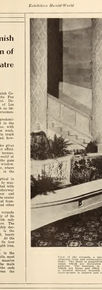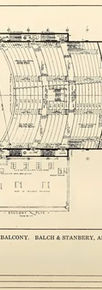History at a Glance
Credit: Visit Stockton
1916: The first theater in this location, the T&D Photoplay, is built on East Main Street in Stockton, California by the Wilhoit family and used for a variety of entertainment acts. The same site will later be occupied by the Bob Hope Theatre.
1921: Fox West Coast Theaters Inc. leases the T&D, remodels it and renames it the California.
1929: After several years of successful operation, the California is leveled and plans are drafted for a new theater to serve the thriving city of Stockton. Fox West Coast Theaters reaches an agreement to lease the property for a period of 50 years and invests nearly half a million dollars to build a luxurious, safe and comfortable theater - the Fox California, or the Fox.
1930: The opening of the Fox on October 14 is one of the most grandiose events in the region. Approximately 20,000 people attend the celebration, including some of the most famous stars of the time. Opening acts include the latest “talkie” movies and comedy skits. The Fox is the largest vaudeville house in California, with 2,170 seats. The theatre is also one of the safest buildings of the time, built entirely with cement and steel, with the ability to evacuate guests within two minutes. One of the jewels of the theatre is the $40,000 (in 1930) three manual Wurlitzer pipe organ with twin pipe lofts. Ticket prices are 50 cents for general admission and 65 cents for box seats.
1931: The Fox California celebrates the success of its first year in operation with a weeklong celebration. It is speculated that nearly a million people were entertained during the theatre’s first year in business.
1930s: The Fox California predominantly shows movies due to the owner’s close association with the large motion picture studios. However, stage acts and other variety acts are also presented at the Fox, including Al Jolson, one of the greatest entertainers of the time; the Marx Brothers; Ted Lewis, a clarinetist and member of one of the most popular jazz bands of the period; and Henry Lauder, a famous Scottish comedian.
1940s: Big bands of the 1940s perform at the theatre.
1960s: Famous bands such as Duke Ellington, Paul Whiteman and the Dorseys play on the Fox stage.
1971: A local company, Westland Theatres, buys the rights to the Fox California. A declining business climate and the growing competition from drive-ins and television impact the profitability of the theatre. Despite efforts to keep the theatre in business, attendance declines.
1973: The Fox California closes its doors to the public due to lack of business. The last shows are “Sweet Jesus,” “Preacher Man” and “Marlowe.”
1974: A special showing of the movie “Billy Jack” plays at the Fox. Concern rises among citizens that the Fox will be demolished to make room for a civic parking lot or other development.
1981-1985: Rocking Chair Productions produces a few rock concerts at the Fox.
1979: The building is purchased by Edward C. Merlo and Madeleine Lawton who seek to save the building from destruction. They are ultimately successful in their efforts to save the historic structure and the Fox Theatre is placed on the National Register of Historical Places. Today it is one of only two movie palaces left in the Central Valley.
1985-1988: Offshore Productions offers jazz and country music entertainment that doesn’t draw significant audiences.
1991: The Redevelopment Agency of the city of Stockton includes the Fox California as part of an effort to revitalize the downtown area and other parts of the city.
1995: The Redevelopment Agency leases the theatre and hires a promoter and booking agent in an attempt to develop a viable, on-going program at the theatre, and begins small renovations of the building. Several events and concerts are held at the Fox.
Late 1990s: The mayor and city council begin a large scale renovation of the Fox. The Redevelopment Agency is the primary financial sponsor of the project.
2000: Anita J. Merlo and the Merlo Fox Building Trust donate the theater building to the city of Stockton in honor of Edward Charles Merlo, architect. Bob Hartzell, president of Friends of the Fox, a nonprofit organization that supports the Fox Theatre, orchestrates the refurbishment of a 1928 Robert Morton pipe organ that will be placed in the renovated Bob Hope Theatre. Once restored, the organ will be worth between $160,000 and $200,000.
View original article here.

_edited.png)




























